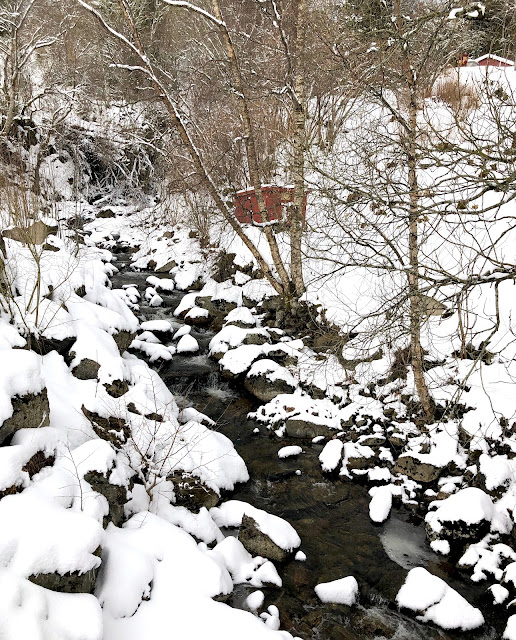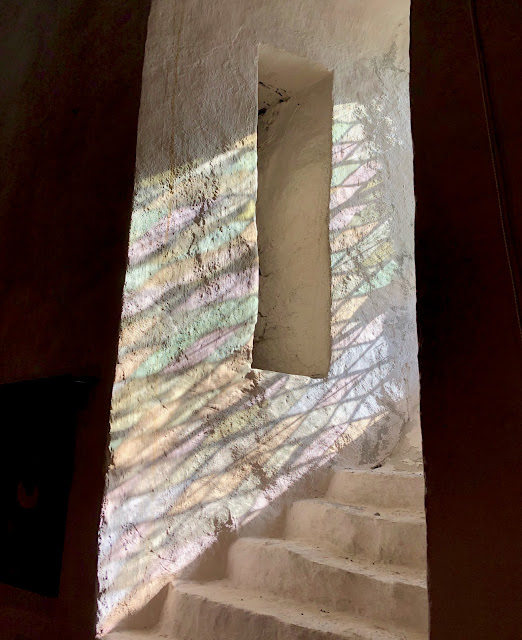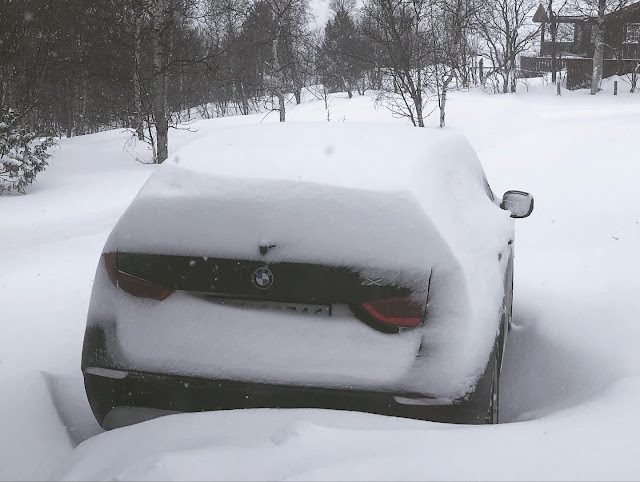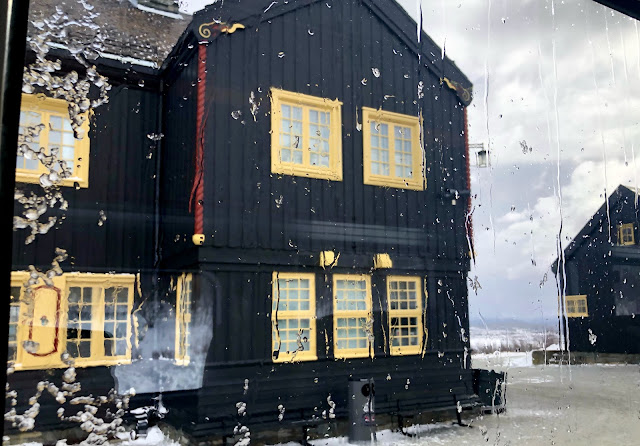 |
| Just one of the 200 sculptures celebrating the human life cycle at the magnificent Vigelandsparken, on central Oslo's western fringe |
Welcome to Part 2 of our recent return to Norway after a 2.5-year absence, due to the pandemic.
It's many years since we spent any real time in Oslo. I think the last occasion we were there was just for 4-5 hours while we awaited our connecting flight back to London, possibly 5-6 years ago. Prior to that it must be something like 2008 since we actually spent a couple of days in the city (where did all those years go?!).
For this return visit we purchased an Oslo Pass and got our money's worth, jumping on and off buses, trams and ferries, and taking advantage of the included free entry to museums. If you're visiting Oslo for the first time we highly recommend getting a 24 or 48 hour pass. There is so much to see, and being able to give your feet a rest by using the amazingly efficient and reliable public transport system is invaluable. We can particularly recommend tram route number 12 which is a great one for tourists - just get on and ride the whole circuit to get a feel for the city before exploring in greater depth. Despite utilising public transport, we still managed to clock up 10-15km of walking each day.
I really picked a winner with our temporary digs in central Oslo. Our home for three nights was a comfortable and beautifully decorated apartment just 5-10 minutes' walk from Oslo S (the main railway station), as well as from the fjord-side Opera House and Munch Museum. Like every other Norwegian dwelling, it combined design flair with superb functionality. We absolutely loved it.
The apartment scored bonus points for having not one, not two, not three, but FOUR different coffee makers: a gorgeous Stelton cafetière, a drip filter coffee machine, a Nespresso pod machine and an Italian metal stovetop espresso pot. Now, some of you might think that excessive. I call it freedom of choice for the discerning coffee drinker.
 |
| Yours truly in front of the entrance to our Air B&B apartment on Dronningensgata in central Oslo. Norway's largest newspaper - Aftenposten - was founded in the building next-door |
 |
| *swoon* Take a look at this mid-century modern aesthetic: our Air B&B apartment in central Oslo (on the 7th floor) |
 |
| View from the terrace of our Air B&B apartment in central Oslo |
The architectural landscape of Oslo has undergone some quite dramatic changes in recent years, not least with the addition of the building housing the Norwegian Opera and Ballet (Operahuset) which, like multiple other visually stunning buildings across Norway, was designed by the company Snøhetta.
This striking building sweeps down into the Oslo Fjord, and like many projects in this very egalitarian country, it has been designed to invite the public to explore and interact. A broad ramp leads up to the top of the building and behind, and down the other side. It is perpetually filled with citizens of Oslo and tourists, all admiring the views and enjoying space to laze in the sun.
The interior is no less exciting, with a horseshoe-shaped main auditorium clad in golden oak, bringing warmth to a structure that is otherwise predominantly glass, designed to optimise views of the Oslo Fjord.
 |
| Inside Oslo's Opera House - the exterior wall of the horseshoe-shaped auditorium, clad in oak and with sloping ramps leading to the various tiers |
Also much expanded and developed in the past decade is Aker Brygge, historically a run-down wharf area but in recent decades known for hip cafés, bars and restaurants nestling the Oslo Fjord. It's a bustling and vibrant area, providing open air spaces for events and incorporating glamorous shops, amazing apartments and the Astrup Fearnley Museum of Modern Art.
It is teeming with people all year round, but absolutely heaving in summer.
 |
| The Astrup Fearnley Museum of Modern Art - Aker Brygge, Oslo |
 |
| So many interestingly designed apartment buildings in Aker Brygge, along the Oslo Fjord |
 |
| Yes, folks - here in Oslo's Aker Brygge area you may hire a floating sauna right on the fjord (link to this company's website here) |
As much as I love modern architecture and it was a treat to see the way Oslo has been developing in the past decade or so, as regular readers will know, I am probably more drawn to historic buildings. And again, Oslo does not disappoint. Just 5-10 minutes' walk from our apartment was Karl Johan's Gate (gate is the word for 'street' in Norwegian), a wide avenue which is partly pedestrianised and runs all the way from Oslo's central railway station at the bottom to the Royal Palace at the top, passing Stortinget (the Norwegian Parliament building). Both Karl Johan's Gate and the surrounding side streets are filled with beautiful and elegant buildings.
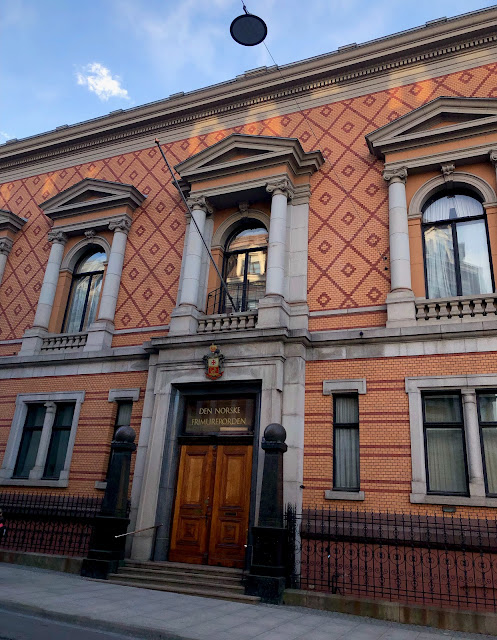 |
| Er... this is actually the headquarters of the Norwegian Order of Freemasons 🤭 But a beautiful building, all the same |
 |
| Stortinget - the Norwegian Parliament Building |
 |
| Theatercaféen - opened in 1900 and named thusly because it stands opposite the National Theatre in Oslo |
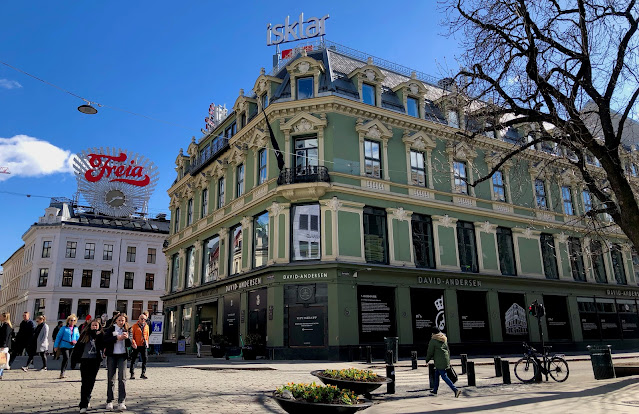 |
| More gracious buildings along Karl Johans Gate in Oslo. The 'Freia' clock is iconic, representing Norway's premier chocolate company |
Returning to the topic of contemporary architecture, the Munch Museum was an absolute treat.
I loved the old museum which was opened in 1963, located in Tøyen in the borough of Gamle Oslo ('old Oslo'). It housed at least half of all Edvard Munch's works in its permanent collection. However, such is the popularity of Norway's most famous artist that in 2008 the City of Oslo held a competition for the design of a larger museum, to be located along the fjord, closer to the city centre.
The new museum opened finally in October last year (2021). I think it's a magnificent building, truly, despite its design generating love and hatred in equal measure. The views from the upper floors are incredible, and the whole thing has a feeling of space which, to my mind, is superbly juxtaposed against the claustrophobia of some of Munch's works.
 |
| The Munch Museum in Oslo, opened in October 2021 |
 |
| The upper floors of the Munch Museum provide fantastic views over Oslo |
 |
| Viewed from the Munch Museum in Oslo: Foreground - Recently developed apartment buildings Background - the series of modern buildings known as The Barcode |
But of course, the really important element of this building is the art. And what an output from this troubled artist! It's awe-inspiring to see such a huge volume of one artist's work in one place.
I've always been drawn to the tortured soul, and Munch's work strikes a chord with me. I recognise the despair, the hopelessness represented in his portraits. The work is informed by his early experience of illness and grief, losing his mother and a favourite sister during his childhood. One of Munch's sisters was diagnosed with a mental illness at an early age, and he himself suffered from depression, culminating in a breakdown when he was 45.
Is it any wonder that many of his works represent the sick room, bereavement, melancholia and despair. But there is much beauty as well, and it's fascinating to mark the development of Munch's style over the decades.
Naturally Munch's most famous work is exhibited in the gallery. In fact there are several versions of Skriken (The Scream) which is acknowledged as one of the most recognisable images in the world. Currently there are three on rotation - the painting itself, a drawing and a lithograph.
 |
| Lithograph of Skriken (The Scream) - Munch Museum, Oslo |
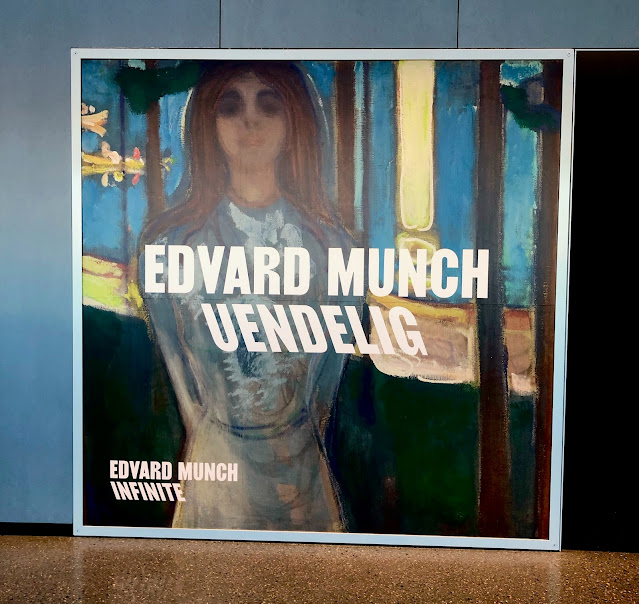 |
| Entrance to the Uendelig ('infinite') exhibition which occupies one of the floors of the Munch Museum in Oslo |
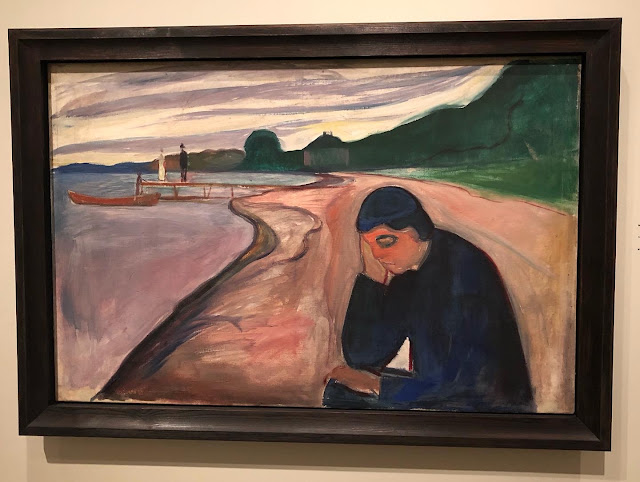 |
| 'Melancholy' - Edvard Munch, 1893 Munch Museum, Oslo |
 |
| 'Death and the Child' - Edvard Munch, 1899 Munch Museum, Oslo |
 |
| (detail) 'Death and the Child' - Edvard Munch, 1899 Munch Museum, Oslo |
After a couple of hours in the Munch Museum we decided to revisit some old haunts, including the superb Vigeland Park which celebrates the life's work of sculpture Gustav Vigeland (1869-1943).
We also attempted to take a ferry from the Opera House to the island of Bygdøy which houses a number of Oslo's finest museums, as well as being chock-full of charming residential houses. It's a very well-to-do area.
I say 'attempted' because we had some unexpected excitement after boarding the ferry for the 20-minute journey to Bygdøy. The route makes a number of stops and we were approaching the first of these when the attention of all eight passengers was drawn to the cockpit (we were spread out on bench-type rows of seating, all facing the cockpit) where the four crew were located. A voice, becoming gradually louder and more anxious, exclaimed 'Oh, nei, nei, NEI, NEI !!!!!!' and we watched in horror as the crew gathered around the wheel, desperately turning it as fast as it could be turned, as we approached the jetty at full speed. Kevin informs me reverse thrust had been fully engaged but it was to no avail - we hit that jetty hard.
The impact was such that the passenger at the rear of the vessel - who did not have bench seating in front of him - was propelled to the floor, my sunglasses flew right off my face and forward several rows, and the rest of us sat rubbing our knees, having been flung towards the row of seating in front. The skin on our knees was broken through our clothes and Kevin and I nursed bruises for about a week.
My immediate thought was to locate the life jackets and prepare for sinking! Thankfully damage to the vessel was limited to a gigantic dent in the solid steel hull, and the ferry was immediately docked and we disembarked, with casual instructions from the crew to walk to the next ferry stop. We understand there was a trainee driver at fault, but nobody panicked and no details of passengers were taken etc. There were a couple of Americans on the boat and we wondered if they would be filing a claim...
With no lasting effects aside from perhaps mild scars on our knees, we walked to the next ferry stop and travelled in safety to Bygdøy. At least this incident made the trip to Oslo truly memorable!
 |
| Re-creation of a typical small town across the 17th - 20th centuries - at the open-air Norwegian Folk Museum on Bygdøy, Oslo |
 |
| Farm buildings from the region of Setesdal, transported to the Norwegian Folk Museum in Oslo |
 |
| Injury sustained from the ferry crash en route to Bygdøy |
 |
| Our ferry after the crash - you can't see it, but there's a dirty great dent in the steel bow |
 |
| The Monolith (also referred to as The Obelisk): the towering pinnacle of Gustav Vigeland's incredible body of work in what is referred to as Vigeland Sculpture Park - in Frogner Park in Oslo |
 |
| Gates designed in the 1930s but not installed until 1952, after the artist's death - Vigeland Sculpture Park, Oslo |
 |
| Another shot of The Monolith and surrounding sculptures. Vigeland Sculpture Park in Oslo is the world's largest sculpture park by a single artist |
 |
| Vigeland Sculpture Park in Oslo has multiple works where the figures are contained within wheels, continuing the park's overall theme of the circle of life |
The fabulous weather in Oslo inspired us to venture to a new spot, the historic neighbourhood of Kampen in the Gamle Oslo ('old Oslo') borough. This was just a short tram ride from where we were staying, and well worth the journey despite me having the poor luck to pick the one day of the week when the café I was keen to visit was closed.
Kampen's streets abound with colourful 19th century timber and brick cottages, all painted in jolly colours.
 |
| Timber cottage in the Oslo neighbourhood of Kampen, just 5km from the city centre |
 |
| A vibrant colour scheme for this brick building in Kampen, Oslo |
 |
| Florist in Kampen, Oslo |
 |
| Another example of the rainbow colours of houses in Kampen, Oslo |
For us, no trip to Norway would be complete without a visit to a supermarket where, despite many shopping experiences over the decades, we are always delighted by the interesting goods on offer. I'm a huge fan of knekkebrød (crispbread), having been raised on the limited versions available to my immigrant father in Australia in the 1960s and 1970s. In other words, mostly Ryvita but we were able to obtain Kavli and Finncrisp by the 1980s - *deep joy*
The picture below illustrates the abundance of knekkebrød choice available in your average supermarket in Norway, and we always stock up on multiple packs to bring back to England with us.
 |
| Now that's what you call a decent selection of crispbread. The ones in the sky-blue boxes are among our favourites - the Kornmo brand |
Other culinary temptations abound in this horrifyingly expensive city, and we were content to take a deep, fortifying breath and indulge in some of them. We'd travelled a long way and it was our first trip abroad in nearly 2.5 years, so we were determined to splurge here and there.
Oslo is perhaps not as well known as the other Scandinavian capital cities which have been spotlit in recent years - Stockholm, Copenhagen, even tiny Reykjavik. However if you've never visited, I highly recommend you do. It's a template for the perfect city; it has it all: a beautiful setting on the Oslo Fjord, lovely and historic buildings interposed between cutting-edge modern architecture, and an abundance of cultural delights. With a modest population of approximately 650,000*, nothing is crowded. Everything works. It's beautifully clean and well maintained, the people are all well fed and stylishly dressed. Yes, it's eye-wateringly expensive but you will never be disappointed by quality.
* Greater Oslo has a population of 1.3 million
On our last evening in Norway we decided to splurge on a restaurant meal at a family-run Italian place just a two-minute stroll away from our Air B&B apartment (justnaround the corner from the konditori!). We knew the prices on the menu would raise our blood pressure but we'd been economising for days by buying supermarket food and packing our own sandwiches and fruit for lunch most days - not forgetting taking advantage of that free coffee and chocolates on the train from Oppdal! So we felt our splurge was warranted.
It was a good decision - the staff were friendly, the pizza was absolutely delicious and it was a nice way to end the trip. It felt very indulgent, as you will understand from the photo captions below.
 |
| For Australian readers, that's A$15 for a glass of beer, and A$22 for a glass of wine. We sipped slowly and savoured every drop! |
 |
| Yes, this little tableau of beverages represents something like £27 / A$47 |
And finally, a round of applause for a country that considers life is much nicer when things are both functional and beautiful. A country where somebody comes up with the idea of embellishing that most basic of household supplies, the loo roll, with a simple graphic that perfectly illustrates the origins of said product... and the country responds 'Well, why not?'
 |
| I would never have imagined my happiness could be increased by decorated toilet paper. I was wrong. Bravo, Norway 👏 🇳🇴 |
I'm hoping it's not too long until we can travel again. It's worth airport delays and frustrations, as long as you are going to the right places. And Norway, as I've always known, is one of them.
 |
| Kevin and Yours Truly, exploring Aker Brygge in Oslo |
Until next time,


.jpeg)






.jpeg)








